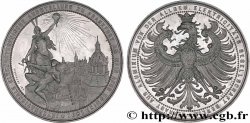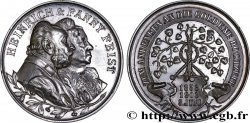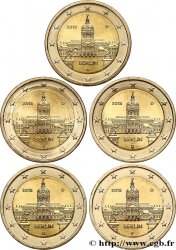Volver 1/1
fme_481051 - ALEMANIA Médaille pour le rétablissement du service militaire
No disponible.
Artículo vendido en nuestra tienda (2020)
Precio : 180.00 €
Artículo vendido en nuestra tienda (2020)
Precio : 180.00 €
Tipo : Médaille pour le rétablissement du service militaire
Fecha: 1935
Nombre del taller / ciudad: Allemagne
Metal: plata
Milésimas de pureza : 900 ‰
Diámetro: 36 mm
Eje de acuñación: 12 h.
Peso: 19,55 g.
Canto: inscrite en creux : .BAYER. HAUPTMUNZAMT. SILBER 900f (traduction : Institut monétaire de Bavière. Argent 900)
Comentarios sobre el estado de conservación:
Patine grise hétérogène suite à un ancien nettoyage. Présence de petites rayures
N° en los catálogos de referencia :
Kienast507
Anverso
Titulatura del anverso: WEHRWILLE - WEHRPFLICHT // 19 - 35 / 16. / MARZ.
Descripción del anverso: Homme nu de face tenant une épée de ses deux mains; signé : K. G..
Reverso
Titulatura del reverso: LIEGT. DEUTSCHE. EHR. IN. DEUTSCHER. WEHR -.
Descripción del reverso: Ancre ailée accostée de deux grenades.
Comentario
L’ancre ailée accostée des grenades est une allégorie des forces armées sur terre, eau et air. La date du 16 mars 1935, en Allemagne, correspond au rétablissement du service militaire obligatoire et porte les effectifs de la Wehrmacht de 100 000 à 500 000 hommes. Cela sera la première violation flagrante du traité de Versailles d’après l’article Hérodote.
(https://www.herodote.net/16_mars_1935-evenement-19350316.php)
K. G. de son nom entier, Karl Xaver Goetz, est un médailleur allemand né en 1875 et mort en 1950. Il réalisa des oeuvres de style Art Nouveau mais fut particulièrement connu pour sa série satyrique fabriqué pendant la première guerre mondiale et après (1913-1923). Puis, il créera des médailles dans le style néo-classique portraiturant des hommes politiques comme Paul von Hindenburg.
The winged anchor flanked by grenades is an allegory of the armed forces on land, water and air. The date of March 16, 1935, in Germany, corresponds to the reestablishment of compulsory military service and increases the strength of the Wehrmacht from 100,000 to 500,000 men. This will be the first flagrant violation of the Treaty of Versailles according to the article Herodotus. (https://www.herodote.net/16_mars_1935-evenement-19350316.php) KG, his full name, Karl Xaver Goetz, is a German medalist born in 1875 and died in 1950. He produced works in the Art Nouveau style but was particularly known for his satirical series made during the First World War and after (1913-1923). Then, he created medals in the neoclassical style portraying politicians such as Paul von Hindenburg
(https://www.herodote.net/16_mars_1935-evenement-19350316.php)
K. G. de son nom entier, Karl Xaver Goetz, est un médailleur allemand né en 1875 et mort en 1950. Il réalisa des oeuvres de style Art Nouveau mais fut particulièrement connu pour sa série satyrique fabriqué pendant la première guerre mondiale et après (1913-1923). Puis, il créera des médailles dans le style néo-classique portraiturant des hommes politiques comme Paul von Hindenburg.
The winged anchor flanked by grenades is an allegory of the armed forces on land, water and air. The date of March 16, 1935, in Germany, corresponds to the reestablishment of compulsory military service and increases the strength of the Wehrmacht from 100,000 to 500,000 men. This will be the first flagrant violation of the Treaty of Versailles according to the article Herodotus. (https://www.herodote.net/16_mars_1935-evenement-19350316.php) KG, his full name, Karl Xaver Goetz, is a German medalist born in 1875 and died in 1950. He produced works in the Art Nouveau style but was particularly known for his satirical series made during the First World War and after (1913-1923). Then, he created medals in the neoclassical style portraying politicians such as Paul von Hindenburg








 Informar de un error
Informar de un error Imprimir la página
Imprimir la página Comparte mi selección
Comparte mi selección Haz una pregunta
Haz una pregunta Consignar / vender
Consignar / vender
 Descriptivo
Descriptivo















